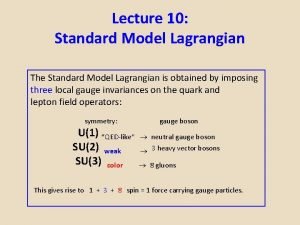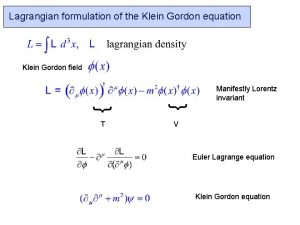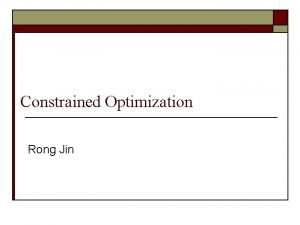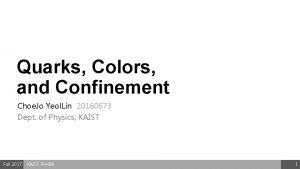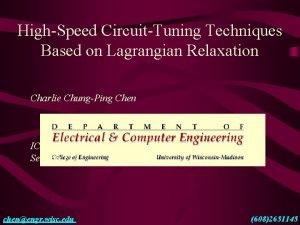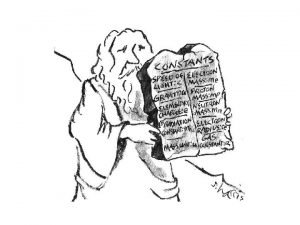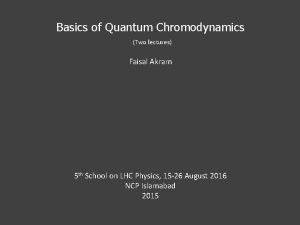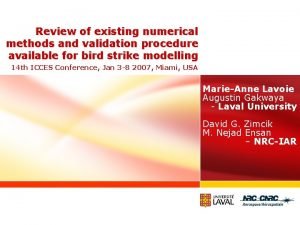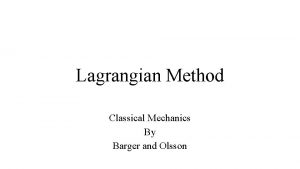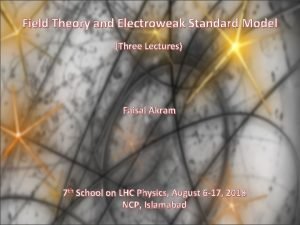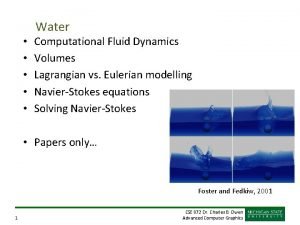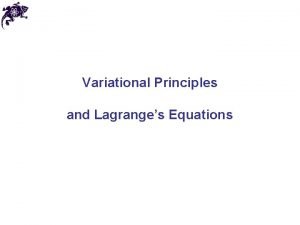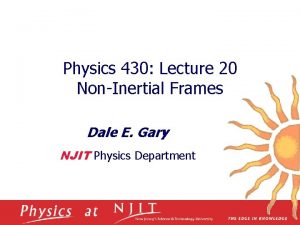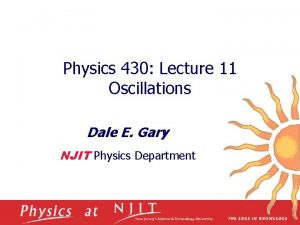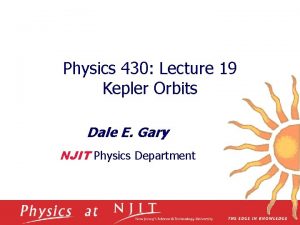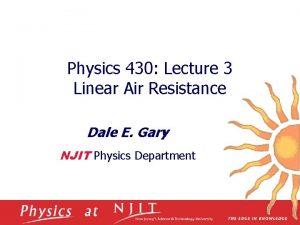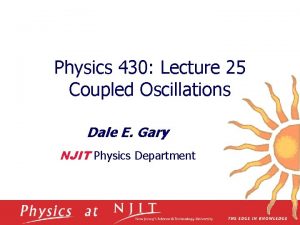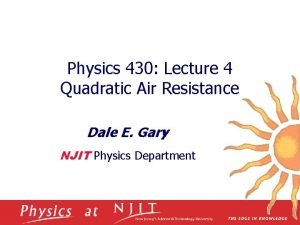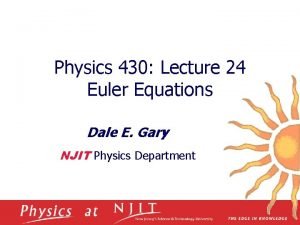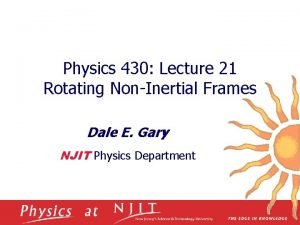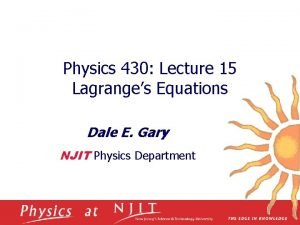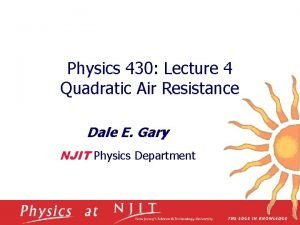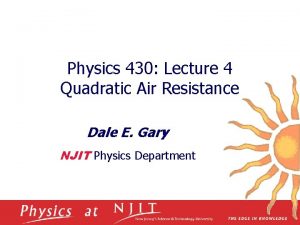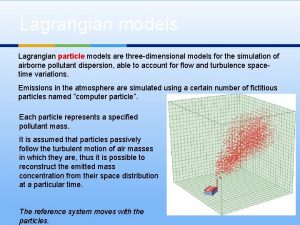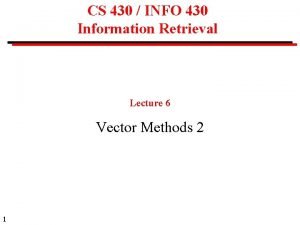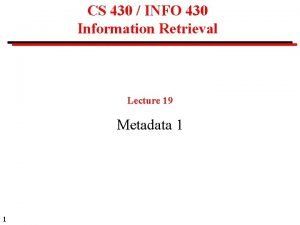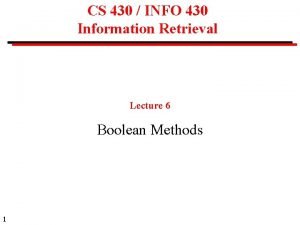Physics 430 Lecture 26 Lagrangian Approach Dale E
















- Slides: 16

Physics 430: Lecture 26 Lagrangian Approach Dale E. Gary NJIT Physics Department

11. 4 Lagrangian Approach—Carts and Springs Let’s do the problem of two carts and three springs using the Lagrangian approach, just to show that we arrive at the same two equations of motion. q In this problem, using the same x 1 and x 2 as coordinates, we easily arrive at the kinetic energy: q q To write down the potential energy, consider the extension of each spring, i. e. x 1 for spring k 1, x 2 – x 1 for spring k 2, and – x 2 for spring k 3. Then the potential energy is q Writing the Lagrangian, T – U, and inserting into the two Lagrangian equations, gives as usual: q The problem then proceeds as before. December 08, 2009

Lagrangian Approach—Double Pendulum There was no particular advantage to using the Lagrangian approach for that problem, but there are others for which the Lagrangian approach is distinctly easier—such as the double pendulum shown at right. q This is just a second pendulum of mass m 2 and length L 2 connected to a pendulum of mass m 1 and length L 1. f 1 L 1 q The two angular coordinates are the obvious ones to use m 1 for our generalized coordinates. L 2 q Note from the figure that the motion of bob two is the vector f 2 sum of its own motion, and that of bob one that it is connected m 2 to. Thus, the kinetic energy is q q Likewise, for U we see that the height of the bobs are L 1(1 - cosf 1) and this height plus L 2(1 - cosf 2) : q But the resulting Lagrangian is not solvable analytically. December 08, 2009

Double Pendulum-2 Instead, we will do a Taylor expansion of the cosine terms to linearize the problem. This will allow us to obtain a solution for small oscillations about the equilibrium position (i. e. about f 1 = f 2 = 0). q Writing cos f 1 – f 2/2, we keep only the leading term in the kinetic energy (because that term is already multiplied by the doubly small term ), and keep both terms in the potential energy: q q Writing the Lagrangian, T – U, and inserting into the two Lagrangian equations, gives as usual: q We now write this to look like December 08, 2009

Double Pendulum-3 q The rest of the solution is just like last time. We look for wave solutions whose real part is the physical solution This leads us to which is solved to find the normal mode frequencies. q Let’s solve this for the case of equal masses and equal lengths: where in the last step I introduced the oscillation frequency for a single pendulum, q Setting the determinant to zero leads to with solutions December 08, 2009

Double Pendulum-4 q Now that we know the normal mode frequencies, we can insert them one at a time into to find the two normal modes. q Inserting w 1, we have which implies q The final result, then, is This means the lower pendulum has a slightly higher amplitude, but they oscillate at the same frequency. You can simulate this is Phun. q A similar analysis for the second normal mode frequency shows q or December 08, 2009

Double Pendulum-5 q The second mode solution, then, is q And, of course, the general solution is considerably more complicated, being a linear combination of the two normal modes. December 08, 2009

The General Case Having seen that we can describe carts on springs and pendulums under gravity in the same way, we want to generalize the discussion to n degrees of freedom (n generalized coordinates q = (q 1, …, qn)). Note that this is not a three-dimensional vector, but rather a vector in the n -dimensional space of the generalized coordinates. q We will assume that the general system is conservative, so that it has potential energy q and Lagrangian L = T – U. The kinetic energy is where the sum runs over all particles, but in terms of the generalized coordinates we can write this as where the coefficients Ajk(q) may depend on the coordinates q (see T for the double pendulum). q Our final assumption is that the system is undergoing only small oscillations, which means we Taylor expand T and U if necessary to make the equations quadratic, e. g. December 08, 2009

The General Case-2 q For T, after Taylor expansion we have q As an example, consider a bead on a wire of arbitrary shape f(x), with a dip (a minimum) at x = 0. The potential energy of the y bead is U = mgy = mgf(x). When we Taylor y = f(x) expand, since f(0) = f (0) = 0, we have q The kinetic energy of the bead is x but, by the chain rule so q Having found the general expressions down the equation of motion. we can now write December 08, 2009

The General Case-3 q This leads to the n general equations of motion q These n equations can be combined into a single matrix equation q Here, q is the n x 1 column vector and M and K are n x n “mass” and “spring-constant” matrices. q As usual, we find the determinant of the characteristic or secular equation to identify the n normal mode frequencies, and plug back in to find the n eigenvectors. q Let’s use this to do one more example, a system of three coupled pendulums with three degrees of freedom. December 08, 2009

11. 6 Three Coupled Pendulums Consider three identical pendulums coupled by two identical springs. We’ll use three angles as generalized coordinates. q The kinetic energy is q f 2 q The height of each pendulum is h = L(1 - cos f) ½Lf 2, so the gravitational potential energy is q The spring potential energy is q Now the text introduces the idea of using natural units, popular among theorists, which is to set “uninteresting” constants to unity, carry through the analysis, and at the end reinsert the constants if necessary. In this case, this means setting L = m = 1, which amounts to dropping them: f 1 December 08, 2009 f 3

Three Coupled Pendulums-2 q We could now write down the Lagrangian and turn the crank to get the equations of motion, but you already know that it will lead to the usual: q All we need to do is read the “masses” and “spring constants” directly from T and U, using This gives the result: The rule is this: if you ignore the factor ½ in front of the equation for U, then the diagonal element Kii is just the coefficient of fi 2, while an off-diagonal element Kij is half the coefficient of fifj. December 08, 2009

Three Coupled Pendulums-3 q The rest of the solution is as before, except we have three x three matrices. We look for wave solutions whose real part is the physical solution This leads us to which is solved to find the (three) normal mode frequencies. q Inserting: q Setting the determinant to zero leads to with solutions q Recall that we may want to reinsert L and m at this stage, to get December 08, 2009

Three Coupled Pendulums-4 q Substituting these in turn into we find the eigenvectors q After inserting this for z(t) and taking the real part, the equations represented by the first normal mode are: q Here is a graphical depiction of the three normal modes: December 08, 2009

The End of the Course, but… We have come to the end of the course, but there are still many interesting topics that we did not have time to cover. Some of these are introduced in Part II of the text, Chapters 12 -16. q Chapter 12 expands on our discussion by considering nonlinearity, which is something we have stayed away from. It is important to realize that in the limit of small oscillations we have gotten away with this, but ALL systems display non -linearity at some level. Chapter 12 shows that one result of nonlinearity is chaos, and there is a vigorous branch of modern study devoted to chaos theory. q Chapter 13 describes a related but distinct formalism called Hamiltonian Mechanics, which uses the total energy T + U, rather that the Lagrangian T - U as its basis. q Chapter 14 introduces collision theory, important in many branches of Physics including my own area of solar radio research. Collisions between ions and electrons in the solar plasma generate much of the radio photons we study. q December 08, 2009

…Not the End of Mechanics Chapter 15 introduces relativistic mechanics, which plays a huge role in high energy physics, and in most electrodynamics even at “non-relativistic” speeds. It is also central to several aspects of astrophysics. q Finally, Chapter 16 discusses continuum mechanics. When we discussed rotation of rigid bodies in Chapter 10, we had to assume they were rigid, i. e. did not deform. However, in practice most bodies do deform when they interact, so if we want to treat collisions or other interactions of macroscopic objects we have to study continuum mechanics. q q The point is that you should at least leaf through the material in these chapters and see what they contain. The chapter on chaos is particularly interesting and surprising. With what you have learned so far in this course, you should be able to handle the new material contained in these chapters. Use the Christmas break to spend a little time with it. q You’ve been a great class, and as usual I learned a lot in teaching this. I hope you have, too. December 08, 2009
 01:640:244 lecture notes - lecture 15: plat, idah, farad
01:640:244 lecture notes - lecture 15: plat, idah, farad Lagrange multipliers
Lagrange multipliers Standard model lagrangian
Standard model lagrangian Klein gordon lagrangian
Klein gordon lagrangian Standard model lagrangian
Standard model lagrangian Lagrangian optimization
Lagrangian optimization Eulerian vs lagrangian
Eulerian vs lagrangian Lagrangian
Lagrangian Lagrangian relaxation tutorial
Lagrangian relaxation tutorial A cyclic coordinate is in hamiltonian
A cyclic coordinate is in hamiltonian Stranglet
Stranglet Quantum chromodynamics lagrangian
Quantum chromodynamics lagrangian Lagrangian
Lagrangian Lagrangian
Lagrangian Standard model
Standard model Incompressiblity
Incompressiblity Euler lagrange
Euler lagrange


